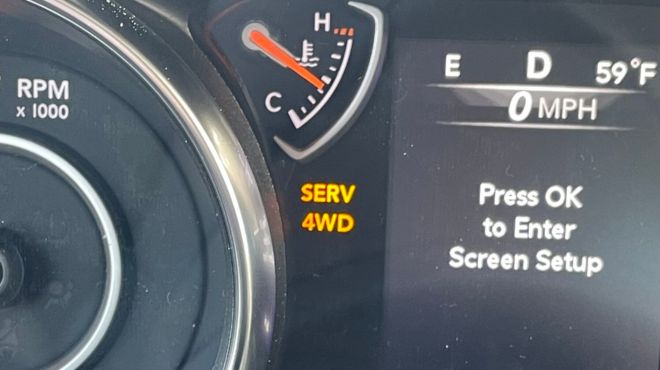If you’ve ever driven a Jeep or another 4×4 vehicle, you know that extra capability and confidence that comes with having power delivered to all four wheels. But sometimes, things can go wrong with even the toughest 4WD systems. That little amber “Service 4WD” light striking up on your dashboard indicates issues detecting or distributing torque properly in your Jeep.
The Service 4WD light has many potential triggers. Sensor problems, electrical issues, worn parts, low fluids, or malfunctions in the 4WD system components can cause the light to come on, indicating a problem with sending engine power properly to both front and rear axles.

Don’t panic yet – it doesn’t always mean catastrophe. But it does mean further diagnosis and service is required soon to restore that special traction advantage Jeeps are known for.
What Exactly is the Service 4WD Warning Trying to Tell You?
The Service 4WD light can seem cryptic if you’re not a mechanic. Simply put, it’s your Jeep’s way of saying: “I’ve detected a problem with the system that sends torque from the transfer case to both axles. Something is stopping me from being able to shift seamlessly between 2WD and 4WD operating modes.”
Most often, the light indicates a solenoid or actuator issue that’s preventing the transfer case from appropriately diverting power to the front and rear axles when you engage 4WD. It’s the check engine equivalent focused specifically on your Jeep’s unique traction capabilities.
While you may be able to limp along in 2WD mode for a bit, it’s risky to keep driving long with the light on. Traction will suffer, components can wear out faster, and you may get stuck just when you need 4WD the most. Let’s explore common culprits and how to restore your Jeep’s four-wheeled confidence.
Also see – Service Shifter Jeep Warning: Causes and Fixes
What Causes the Service 4WD Light to Come On?
Bad Battery or Alternator
If your Jeep’s battery or alternator goes kaput, there may not be enough consistent electrical current to energize the systems that operate 4WD mode. The light comes on because the computer detects abnormal voltage. Before panic sets in, use a voltmeter to confirm your battery and alternator are actually failing to provide sufficient and steady power. Replace them if needed to restore flowing electricity to your 4WD components.
While a sketchy power supply is one possibility, unfortunately there are a host of other potential gremlins that could be tripping that amber alert light up.
Blown Fuses
Another simple issue that can cause Service 4WD headaches is a blown fuse. Your Jeep’s four-wheel drive system relies on numerous fuses to protect the complex electronic components and actuators that shift between 2WD and 4WD. If they blow, communication breaks down.
Start diagnosis by checking the clearly labeled 4WD fuse box under the hood. The 20 amp FDCM EDIFF fuse is a common offender linked to the light coming on. Pop it out to inspect the wire inside – if it’s fried, replace it with an intact fuse of the same amp rating. This small restoration of electrical flow may get your 4WD back online.
However, a blown fuse is often a clue that an underlying electrical short or fault led to excess current frying it in the first place. So the light may come back on even after swapping in a good fuse unless you address the root wiring issue. Time to check other possibilities.
Fault Codes
The most valuable clue to pinpoint what’s amiss with your Jeep’s 4WD system often lies in the fault codes stored in the truck’s computer network. When a sensor or solenoid behaves outside normal parameters, it triggers an error code that will illuminate the Service 4WD light.
To access these codes, you’ll need an OBD2 scanner tool. Unlike a regular code reader, these more advanced scanners that can pull manufacturer-specific codes from your Jeep’s transmission and transfer case control modules. Carefully plug the scanner into the port usually found under the dash.
Pay attention to codes related to shift solenoids, the transfer case motor, wheel speed differences between axles, and 4WD control module issues. The specific trouble code narrows down the sketchy component. For example, “TCCM Solenoid G 2-3 Fault” indicates glitches shifting the transfer case out of 2WD.
Once you know the trouble code(s), further internet searches can reveal the likely fix for that specific situation. Of course, comprehensive mechanic diagnostic tests are best to confirm. But decoding the basic fault messages provides a great starting point!
Malfunctioning Front and Rear Axle
Problems with your Jeep’s front and rear axle components can also trigger the Service 4WD light. These crucial drivetrain pieces channel torque from the transfer case to the wheels—so if they malfunction, applying 4WD power is disrupted.
Specifically, the axle actuator motors receive instructions from the 4WD control module to lock and unlock the axles in preparation for routing torque. If the actuators and accompanying wiring fail, the computer’s commands get lost in translation.
You’ll want to inspect front and rear axle sensors and wiring first. Check for damaged connectors or corroded pins that could cause faulty signal transmission. Ensure actuators with integrated control modules haven’t been contaminated by water or debris. Scan for any stored DTC trouble codes related to “axle unlock” or “excessive wheel slippage” as well.
Axle components like shafts, bearings, differentials, and locking hubs can also wear out over time, leading to 4WD performance loss and light activation. Have a mechanic thoroughly examine the mechanical condition and tolerateances of the axle system. Catching these issues early prevents further drivetrain damage down the road!
Electrical System Problems
As an integrated system of electronic and mechanical components, your Jeep’s 4WD relies heavily on circuitry and wiring staying intact. So if there are any shorts, damaged wires, drained batteries, blown fuses or connection issues, the service 4WD light illuminates.
Start by thoroughly inspecting the condition of 4WD wiring harnesses, plugs and grounds. Any corrosion, rubbing damage or loose plugs can cause signal issues between sensors and control modules. Reset connections and clean any buildup. Electrical tape any slight wire damage.
Check voltage levels at relevant 4WD electronic modules using a DVOM multimeter. You want clean, stable power around 12-14 volts. Fluctuations point to short circuits that need tracking down.
While chasing electrical gremlins, don’t forget to scan for any stored trouble codes about specific sensor failures like the brake switch signal, wheel speed sensors or sensor power supply circuits. These DTC clues reveal wiring issues needing repair.
If all electrical checks pass inspection, it’s time to move deeper into the mechanical 4WD components themselves. Fragile sensors, solenoids and motors often flake out over the miles.
Also see – Service Air Suspension System Immediately: Causes and Fixes
Faulty Sensors and Switches
Modern vehicles rely on sensors and switches to feed crucial data back to control computers. When it comes to 4WD operation, these inputs relay information about vehicle speed, wheel slippage, brake pedal position, gear selection, and much more.
So if these sensors or switches fail due to contamination, wear or damage, your Jeep’s 4WD controller can’t properly distribute torque or authorize shifting – up pops the warning light.
Some common culprit sensors include:
- Wheel speed sensors: Compare readings between all four wheels to detect failing units. Clean sensor rings and tone wheels if buildup causes erratic signal.
- Transfer case shift position sensor: Faulty readings block actual case shifts, check connector and resistance specs.
- Brake light switch: Signals 4WD mode changes, inspect function and harness plugs.
- TCCM transmission sensors: Monitor clutch and gear status, inspect range sensor screens for debris blocking optical path.
Even something like a failing vehicle speed sensor can have downstream effects, preventing smooth 4WD transitions. The key is tracking down the specific out-of-whack sensor from trouble codes or diagnostic testing.
Faulty 4WD Actuator
Actuators play a pivotal role in 4WD operation – these motorized units physically lock and unlock axles and transfer cases in response to electrical inputs, enabling torque flow. When actuators stick or jam, the entire 4WD shifting process grinds to a halt – hello Service 4WD light.
Most transfer case actuator problems stem from contamination issues. Inspect actuator gears, shafts, and solenoids for built-up debris that creates resistance and prevents smooth range shifts. Carefully clean components if needed.
Failing Drive Shafts
Examine actuator wiring as well. Any rubbed-through spots in the harness can provide false signals. And make sure actuator motors receive battery voltage during shift commands. Jumping 12V directly to the actuator should create audible clicks and smooth motion if the motor itself is still functional.
Drive shafts also link key drivetrain components like axles and transfer cases to channel twisting force. If balanced CV joints start failing from miles of driving and articulation, driveline vibrations ensue. The resulting “shuddering” gets interpreted by TCCM computers as powertrain issues, triggering warning lights.
Faulty Transfer Case Motor
The transfer case shifts power between 2WD and 4WD modes using a small electric motor, activated by the driver or vehicle computers. If the motor or related gears develop mechanical resistance from contamination or wear, the case can’t transition properly. Scan for trouble codes about “transfer case motor circuits” to confirm. Inspect inside the case for metal shavings indicating damaged gears.
Damaged 4WD Control Unit
Each Jeep 4WD subsystem – be it the transfer case, axles or drivetrain – relies on local microprocessor modules to coordinate everything. If these control units get damaged from electrical spikes, water ingress or vibration, communication breakdown ensues. Modules may need reprogramming or full replacement.
Tracking errors in the “brains” of a 4WD system takes advanced diagnostics. But know thatfried control modules can certainly contribute to the cursed Service 4WD message lighting up when shifts are commanded.
Time to complete more troubleshooting and tracing of the issue through connectors, wires and specific components within the vast 4WD network!
Worn Out Parts Like Locking Hubs
With enough miles, heat cycles and off-roading, even the toughest Jeep 4WD pieces eventually wear out from sheer mechanical fatigue. And the resulting microscopic cracks or excessive clearances prevent smooth operation.
Locking hubs allow you to disconnect front axles from the drivetrain when in 2WD mode, reducing friction. But their internal gears and rings can erode over time, failing to mesh and lock effectively when you shift into 4WD. Inspect hub internals for signs of metal debris from gear wear.
Axle and transfer case differentials also contain precision gears that can lose teeth or develop sloppy tolerances after intense trail use or towing. Probe differentials by hand to feel any abnormal grinding or looseness signaling compromised function.
Low Fluid Levels
One quick thing to check – make sure fundamental lubricants like transfer case fluid and front/rear differential gear oil haven’t drained out from a leak or cracked housing. The 4WD light comes on because computers detect speed differences between drivetrain parts spinning without sufficient viscous coupling from fluids. Top up any low reservoirs immediately to restore normal power transfer.
Malfunctioning Transfer Case and TCCM
We’ve covered several electrical and mechanical issues in the transfer case itself that can illuminate the 4WD warning beacon. From seized motors to worn shift forks, problems inside this key drivetrain component can prevent smooth engagement of 4H, 4L or 4WD Lock modes.
Advanced diagnostics of transfer case hydraulic flow, encoder motor resistance, pump operation and gear tooth integrity may be required to pinpoint internal hardware failures. Scan for P0869 “4WD transfer case power downgrade” trouble codes. Be prepared for potential tear-down to remedy complex case problems.
The TCCM transmission control module also directs high-level operation of the transfer case by coordinating shift solenoid activation. If the TCCM itself sustains damage, or if there is a software mismatch between it and onboard network modules, you may experience “no low range detected” errors and other false flag issues that switch the light on.
Sometimes No Problem At All
Intermittently seeing the amber 70s icon illuminated on your dash? No trouble codes stored? Before you panic, know that the Service 4WD light also switches on at vehicle start as a bulb check and remains lit if there are any DTCs. So you may notice it upon startup but then goes dark as systems pass pre-drive verification. There may be nothing wrong at all!
Still, diagnosing even phantom 4WD faults requires methodically tracing wires, data signals, power and ground feeds between sensors, switches and computers through every step of the torque delivery path from transmission to tires. Patience and testing is key!
How to Reset the Service 4WD Light?
Before shelling out money and time on mechanic visits, try this method to reset the pesky Service 4WD indicator right in your driveway or garage. The procedure forces onboard computers to reboot their monitoring of the 4WD system and can switch the bulb off without resolving the root issue.
Step 1: Shift Back to 2WD Make sure you’re not actively in 4WD mode. Disengage any locked settings like 4L or 4WD Lock to revert back to standard RWD operation. This takes mechanical strain off transfer case components during the reset.
Step 2: Yank a Precise Fuse Locate the FDCM EDIFF fuse in the underhood box. It will likely be a 20 amp fuse. Carefully pull it out with the fuse removal tool to cut power briefly to the 4WD control module. Don’t touch any other fuses!
Step 3: Take a Quick Test Drive Start the engine and drive a short distance down the road and back. This allows systems to fully deactivate and restart, clearing any ghost errors that may be needlessly tripping the light.
Step 4: Pop Fuse Back In Reinsert your carefully removed fuse to restore normal electronics function. The Service 4WD light should stay dark on next key cycle, potentially fixing your issue!
But be warned – if there are still underlying mechanical or electrical faults plaguing your 4WD operation, the light will most likely switch back on eventually. So consider this only a temporary troubleshooting method, not a cure-all.
Is it Safe to Drive With the 4WD Warning Glaring?
You’ll probably be tempted to ignore that pesky Service 4WD message for weeks and hope it sorts itself out. But it’s really not worth the risks! Driving any extended distance with compromised 4WD can lead to dangerous situations.
Without functional 4WD when you need it, you’ll absolutely lose traction trying to accelerate through mud, snow or steep gravel. Getting stuck in risky conditions is high probability. Wheel slip light activations may even totally immobilize the vehicle as a failsafe.
Just as critically, the mechanical issues causing the warning light often worsen dramatically with extended driving. Axle or transfer case component damage can spread to gear teeth shearing off or drive shafts twisting apart. Transmission and engine connecting points also sustain excess stress.
Fix it Now or Pay For it Later
Getting to a mechanic promptly when the light first appears can help minimize later headaches. Sorting minor sensor glitches, cleaning connectors and catching leaks early is much preferable to replacing seized transfer case motors or blown transmissions down the road!
Of course there’s no sugarcoating it – properly diagnosing and repairing Jeep 4WD issues ranging from worn hub bearings to damaged control module electronics can run anywhere from $800 to $2000 at the shop.
But restoring that precious 4WD function will allow you to keep adventuring off the beaten path safely and prevent rapid deterioration of ALL mechanical systems tied to the drivetrain. Pay now in smaller increments or load up the credit card later after comprehensive breakdowns! Either way, decisive action is recommended over putting your head in the sand.
The Takeaway
Hopefully this guide has shed light on what triggers that ominous Service 4WD warning lamp. While electrical gremlins like blown fuses can occasionally illuminate the symbol, it most often indicates an actual mechanical or hydraulic issue limiting your 4WD system’s functionality.
We covered a gamut of potential culprits – from degraded hub assemblies to wonky speed sensors to seized transfer case components. Any single one can disrupt the delicate coordination between electronic controls and physical driveline parts needed to properly deliver engine twist to all four tires.
While restart cycles, fuse pulls or component cleaning may erase the light temporarily, fully restoring confidence in your Jeep’s traction abilities requires professional diagnosis of root causes followed by repairs. Catching problems early minimizes risks of breaking down in precarious off-road spots or inclement weather with compromised 4WD.
Getting to know the light’s common triggers, how to access potential fault codes, and briefly trying an DIY reset can provide information to share with your mechanic. This gives them a leg up in efficiently tracing issues to help resolve that check 4WD message for good!



